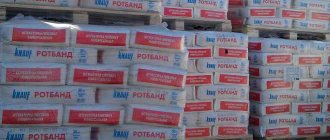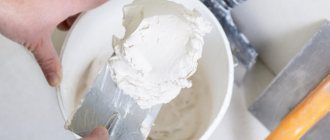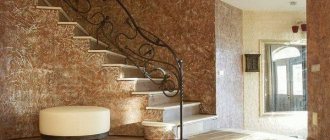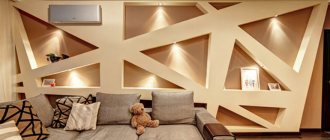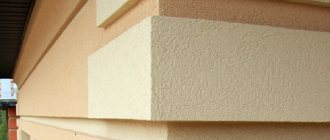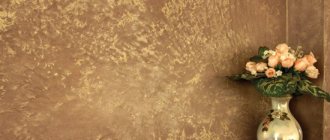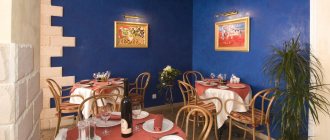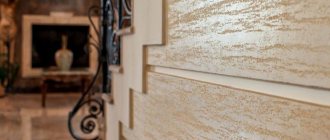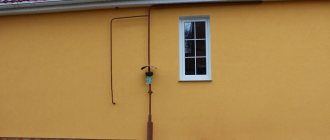What is regulated
The composition and packaging are dictated by a number of standards:
- GOST 9980.3-2014 “Paint and varnish and auxiliary materials, raw materials. Package";
- GOST 9980.4-2002 “Marking”;
- GOST 33083-2014 “Dry building mixtures based on cement binders for plastering work. Technical conditions";
- GOST R 57984-2017/EN 13914-1:2005 “Plaster for external and internal work. Rules for selection, preparation and application";
- GOST 10277-90 “Putties. Technical conditions";
- GOST 25129-82 “Primer GF-021. Technical conditions";
- SP 28.13330.2012 “Protection of building structures from corrosion”;
- SP 71.13330.2017 “Insulating and finishing coatings”.
Recommendations for the use of gypsum plaster, shelf life
The main ingredient of plaster is natural gypsum. It easily absorbs moisture from the environment. Due to the violation of the shelf life of gypsum plaster for a long time, chemical additives do not cope with their functions of maintaining the required level of dispersion. It also contains substances that improve performance characteristics. But they can only be effective if the temperature is maintained. Manufacturers recommend:
- storage of gypsum plaster only in dry rooms; if the humidity in the warehouse exceeds the technical storage conditions, the period is reduced;
- It is important that the condition of the packaging, which partially protects against excess moisture, is not damaged. When used during construction work, it can only be used in dry rooms, for interior work, otherwise the service life of gypsum plaster can be significantly reduced;
- The application layer can be quite large, the main condition is that it must dry well.
Is alabaster a different material or the same?
Because of the confusion that sometimes arises, you need to know how building gypsum differs from alabaster. Recently, even according to GOST, they were considered one material, but now it is customary to distinguish them.
Firstly, alabaster is called calcium carbonate
(calcite) .
This is a fairly hard mineral, which is easy to process. It was from it that the masters of Ancient Egypt and Greece created their alabaster-white creations - sculptures and vessels, and medieval builders used thin plates of alabaster instead of window glass. Alabaster-onyx is used as a finishing and ornamental stone - a type of natural alabaster with a beautiful marble pattern. Now it is mined in North Africa, Mexico and the USA.
The second substance called alabaster is gypsum alabaster
, also known as calcium diacquasulfate, that is, dihydrate β-gypsum. It is used in construction as an independent material, a binder additive and as a raw material for the production of building boards and blocks. The main difference between alabaster and building gypsum is its limited scope of use. It is not suitable for medical work and molding production.
Packaged bags of alabaster and gypsum
Package
Regulated by GOST 9980.3-2014. It happens:
Dear readers! To solve your problem right now,
get a free consultation
— contact the duty lawyer in the online chat on the right or call:
You won't need to spend yours
time and nerves
— an experienced lawyer will take care of all your problems!
- metal;
- glass;
- cardboard, paper;
- polymer.
The choice of packaging depends on the intended content. The materials must not react; the container or bag ensures the safety and tightness of the contents.
The standard provides specific requirements for packaged material. For example, with a weight of 400 g the deviation cannot be more than 5%. Powders - 1.5% in soft containers, 3% in other containers.
Marking
Applied in accordance with the requirements of GOST 9980.4 “Paint and varnish materials. Marking". It must be present on each unit of the lot.
| Intelligence | Example |
| Manufacturer | Russia JSC Lakokraska |
| Material | Primer |
| Net weight | 37 kg |
| Gross weight | 45 kg |
| Number of units per batch | |
| Batch number | № 3 |
| Date of manufacture | 07.12 |
| Designation of the standard or specification | GOST 24595-81 |
| Purpose, application | To prepare surfaces for finishing work. Use strictly as directed |
| Rules for storage and disposal | Store away from sunlight at room temperature |
| Best before date | 18 months from date of manufacture |
In addition, the marking contains special signs that indicate the conditions of storage and transportation of the goods.
Plastering works in St. Petersburg.
Since 2008, it has been developing in the field of plastering, floor screeding and facade insulation. During this period, we have accumulated vast experience in this area and are ready to share it with our customers. We carry out plastering work on any volume, from apartments, offices and cottages to industrial and residential areas. The main criterion that we use in our work is the high quality of finishing work. The main region of presence of our organization is St. Petersburg and the Leningrad region.
In our work, we do not skimp on the equipment we use and therefore use only the most modern equipment from European manufacturers. All employees of our company undergo a rigorous competitive selection process and are professionals in their field. In the staff of our company you will not find “master” generalists. Each employee is a highly specialized specialist, and thanks to this, the high quality of our work is achieved. By contacting us you get a professional partner when carrying out plastering work.
The key area of activity is machine plastering.
The use of mechanisms allows you to achieve undeniable advantages:
- the solution has a uniform consistency since the mixing process occurs automatically
- speed of applying the mixture to the surface
- the cost of mixtures for machine application is significantly lower by 30-40% compared to mixtures for manual application
- Due to the elasticity of the mixture for machine application, it is possible to obtain a smooth surface ready for wallpapering
- provides a 12 month warranty on work.
What can happen if technology is not followed?
To maintain the attractiveness of the facade of the house, it requires proper care. Then the service life of the external plaster will last a long time and the beauty and freshness of the walls will be preserved for a long time. Any building structures are constantly exposed to the negative effects of nature: they damage the cladding of the house. Other causes of damage to the facade arise when the technology for preparing mortars and plastering is violated. Some examples of destruction:
- cracks in the plaster at the seams;
- crumbling plaster;
- defective masonry joints;
- loose bricks near the windows.
- Protrusions of salt (efflorescence);
1.Cracks in the plaster are formed if the base adheres to the wall unevenly, as well as when it dries quickly. Cracks in the seams appear if the seams are poorly sealed and moisture has accumulated there. Also, low-quality solutions were used or the application technology was not followed.
2. The plaster peels off and crumbles due to poor-quality plaster materials. If moisture has accumulated in the wall or frost hits, it will crumble.
3. If there is not enough mortar and the joints are not completely closed, the air in the porous joints will attract moisture. Defective masonry has low strength and poor adhesion to the side surfaces. To make repairs, clean a section of the wall and remove the mortar from the seams.
4. Bricks become loose for the same reasons: moisture. frost and poor quality solution.
5. Sometimes white spots and stains appear on the walls. This is salt that got into the solution during rain. Therefore, plastering must be done in dry weather. Often the composition of the mortar does not match the composition of the clay from which the brick is made. The components combine and cause an unwanted chemical process.
The climate zone where the building is built and the preferences of the owners matter.
Flaws
There are no building materials without flaws. In calcium dihydrate (gypsum), they are mainly associated with water:
- Hygroscopicity. Due to their porous structure, mineral raw materials absorb large amounts of water. This property limits the use of building gypsum in damp environments.
- Low moisture resistance. As a result of getting wet, there is a high probability of deformation of the product or building.
- Corrosion of metal reinforcement laid inside building blocks. Therefore, for the reinforcement of buildings it is better to use natural fibrous materials - wood, reeds, etc.
- Low strength. Side effect of porous structure. Gypsum coating is easy to scratch, and sometimes you don’t even need tools to do it.
Moisture resistance can be improved using filler additives. They can be lime, oleic acid, clay, granulated blast furnace slag, a mixture of soluble glass and dextrin. Another option is to apply finishing coatings to the finished product to prevent water from entering the pores.
Timing and types
Let us analyze the periods of operation of various finishing mixtures.
Plaster
There are many types, each of which has a slightly different composition and special properties: heat or sound insulating. Regardless of the purpose of use, the shelf life is approximately the same.
| Type of plaster | Shelf life (years) | |
| Dry | Ready (factory packaging) | |
| Regular | 0,5 | 2 |
| Thermal insulation | 0,5 | 2 |
| Acoustic | 0,5 | 2 |
| Waterproofing | 0,5 | 2 |
| Decorative | 0,5 | 2 |
| Plaster | 0,5 | 2 |
| Cement | 0,5 | 2 |
putty
An intermediate layer between plaster and the finishing coating of walls or car surfaces. The time of its permissible use is similar.
| Type of putty | Shelf life (years) | |
| Dry | Ready (factory packaging) | |
| Plaster | 0,5 | 2 |
| Cement | 0,5 | 2 |
| Polymer | 0,5 | 2 |
| Adhesive | 0,5 | 2 |
| Oily | 0,5 | 2 |
| For walls | 0,5 | 2 |
| Automotive | 0,5 | 2 |
Primer
Primer treatment is important for high-quality construction and repair work, including machinery.
The manufacturer independently determines the period of acceptable use, usually 18–24 months.
There are several types of primers according to their intended purpose:
- Deep penetration is good for old houses, porous walls, putty coating. The components included in the composition protect against fungus.
- Antifungal is used to protect the walls of rooms with high humidity and insufficient ventilation. Protects against mold and mildew.
- Universal suitable for processing any surface.
- Insulating is used for external surfaces, seams, and gives durability to the treated areas.
- Adhesive provides excellent surface protection, fills pores and microcracks in concrete, enhances structural strength and contact with the coating.
According to the composition they are distinguished:
- Acrylic. Made from resins of the same name with the addition of components that promote hardening and uniform application of the solution. They do not have an unpleasant odor, so they can be used indoors.
- Alkyds are used for surfaces that do not absorb moisture well. The composition contains an organic solvent.
- Mineral ones are resistant to ultraviolet radiation and perform well on alkaline bases. Suitable for processing porous light mineral materials.
- PVA. A popular way to use PVA glue is that it forms a waterproof film. However, it also has a number of negative properties: over time it begins to peel off and turn yellow.
How long can dry construction mixtures be stored?
The shelf life of dry construction mixtures is on average six months (6 months).
How long can dry mixture be stored?
The most important thing in storing baby formula
An open can of baby formula should not be stored for more than 21 days, that is, longer than three weeks. You can store diluted baby formula at room temperature for no more than 3 hours. Diluted baby formula can be stored in the refrigerator for no more than 1 day.
How long can putty be stored?
How long can ready-made putty be stored?
GOST 10277-90 defines the warranty shelf life of putty for all brands as 6 months from the date of manufacture. Manufacturers indicate large values for this parameter. Known finished products have a shelf life of: Polymer Sheetrock - 12 months.
Is it possible to store gypsum plaster in the cold?
The storage temperature of building mixtures should not be too high or, conversely, low. That is, severe frost or unbearable heat are unacceptable. The shelf life of dry construction mixtures is on average six months (6 months).
Is it possible to store plaster on the balcony?
How long is the mixture useful after preparation?
In the refrigerator at temperatures up to +4°C, the finished mixture can be stored for 30 hours. But this is only if the bottle is tightly closed with a sterilized cap, and the baby has not eaten from the bottle.
How can you tell if the mixture is gone?
— How can you tell if the dry mixture has gone bad? — An unusual color of the mixture or an uncharacteristic smell, the mixture is no longer crumbly or sticky lumps have appeared - these are signs that the mixture has already deteriorated. It is better not to take risks and not use such a product.
How long does gypsum plaster last?
Shelf life of gypsum plaster
As a rule, this is six months from the date of manufacture. Its quality depends on the shelf life of gypsum plaster. After 6 months, it may have a poor structure, which makes it impossible to carry out high-quality leveling of the wall surface.
How long can open primer be stored?
Primer manufacturers provide a shelf life guarantee of about 18 months. Some of them were able to extend this period to two years, although it greatly depends on storage conditions. Despite this, expired primer can also be used.
What is the shelf life of tile adhesive?
For example, a dry mixture of cement, sand and polymers - sold as cement-based tile adhesive - lasts on average 6 to 12 months. This period is calculated based on the period during which cement, sand and polymer additives retain their qualities of strength, adhesion (setting), moisture resistance, etc.
How to store sand concrete?
Storing sand concrete requires a serious approach. It is best to store this material in a room with low humidity at temperatures up to thirty degrees Celsius. The package must be closed. In such conditions, the dry mixture can be stored for six months.
How to store Rotband?
How to properly store dry construction mixtures?
To comply with it:
- Store mixtures indoors away from rain and snow.
- Do not place bags on the ground - use pallets or lay a waterproof layer.
- Make sure the packaging is sealed.
- Ensure ventilation of the room - stagnant air leads to the accumulation of excess moisture.
How to preserve exposed cement?
To ensure the shelf life of M400 cement specified by the manufacturer, the material can be stored in bags on pallets, in silos or barrels. Pallets should be insulated from moisture, and the bags themselves should be covered with polyethylene so that the cement does not harden during storage.
Decorative plaster Bark beetle
Decorative plaster Bark beetle is a textured plaster containing small granular pebbles. The material is ready for use and is used in the design of public buildings. Decorative coating is great for decorating offices, restaurants, hotels, and staircases. Since the material has increased resistance to mechanical damage. We offer to buy decorative bark beetle plaster of three main types:
- Decorative plaster Bark beetle interior for painting for interior work
- Decorative acrylic facade wall plaster used for interior and facade work
- Silicone facade textured plaster for facade work
Due to its durability, decorative plaster Bark beetle practically does not collapse over time. It is not washed off by precipitation, is not affected by mold, and also does not shrink during the hardening process when drying after application. The main color of the plaster is white, but you can easily tint it in the desired colors. In this case, the interior plaster applied before painting should be covered with water-based paint. At the same time, the properties of the paint affect the performance characteristics of the finished surface.
Decorative coating Bark beetle is applied to a prepared, smooth plastered surface. The surface can be prepared with a deep penetrating primer. In this case, the consumption of the decorative composition used is 2.5 – 4 kg/m. sq. Decorative plaster is ready for use. It is used for both internal and external facade work.
Composition and properties of bark beetle plaster:
- Filler in the form of crumbs measuring 1.0 – 1.5 – 2.0 – 2.5 mm.
- Resistance to salt solutions
- High resistance to mechanical and atmospheric influences
- Ease of application and high technology
- Solvent-free and odorless
- Economical and highly opaque in costs
- A smooth and matte surface is formed after drying.
- Breathable coating
- Thanks to good adhesion to plywood, cardboard, plasterboard, concrete, foam concrete, stone and brick, as well as fiber chipboards
- The plaster does not turn yellow from exposure to light during operation.
- Explosion and fireproof material
Textured decorative plaster Bark beetle is a fairly popular and well-proven material. The whiteness of the material is 98%. Tinted according to the client's order according to RAL, OLKI, Moscow Palette tables
Depending on the filler crumb 1.0 – 1.5 – 2.0 and the thickness of the layer, the consumption is 2.5 – 4 kg/sq.m.
To reduce viscosity, it is possible to dilute with water in a percentage of no more than 5% by weight of the plaster. Water can only be added after thorough mixing, since the plaster reduces its viscosity under mechanical stress.
The drying time of the textured coating dries to a touch-resistant state is 3 – 5 hours. Complete drying occurs after 24 - 36 hours. Complete polymerization occurs after 7 - 9 days at an ambient temperature of 20 degrees Celsius and a humidity of 65%.
Application and application of decorative plaster Bark beetle
Before applying a textured coating, you need to make sure that the base surface is strong, dry and clean. Additionally and thoroughly clean old oil-based fillers, paints, or other easily crumbling or peeling materials. Treat the base with a deep penetration primer, transparent or tinted finishing decorative plaster.
Mix decorative plaster thoroughly before use. Using a stainless steel float, you need to apply the composition, level it and let it dry for 10 - 20 minutes. Application of the material must be carried out at an ambient temperature of not lower than +5 degrees Celsius and not higher than +35 degrees.
Storage conditions for decorative plaster Bark beetle
The material must be stored in a tightly closed container (original packaging). The ambient temperature should be between +5 and +30 degrees Celsius. Protect the plaster from direct sunlight and moisture.
The warranty on Bark Beetle plaster is 12 months from the date of manufacture.
260
Spadar Spadarovich
- plaster
- dry mixes
Published by Igor Frolov · April 2
Share
Link
Share to other sites
The choice of a constructive solution for the facade of a house puzzles almost everyone who is building or planning to build their own house, or is a developer, read a large construction company.
There are more than two design solutions for facades:
· Plaster facade solutions without the use of additional insulation;
· Plaster facade solutions using additional insulation;
· Systems of suspended ventilated facades and their derivatives;
· Facade solutions using facing bricks.
It will not be a secret to anyone that the simpler the design solution, the more reliable it is, and the longer the service life of the facade will be without any additional costs.
The facade of a building is the outer surface of the outer walls of a building. When deciding on the choice of material for the construction of the external walls of a building, it is necessary to understand and work out the question of not only what material to construct the structural part of the building walls from, but also to understand what and how to decorate their façade.
Considering that external walls must perform both a structural function and an enclosing function (resist atmospheric influences), the wall material must have both structural strength and thermal insulation properties, and ideally, the structural part of the external walls must have the required thermal resistance, which for each climatic zone our country's own.
A reliable façade is a homogeneous façade made on the surface of a single-layer wall. For such a solution, only two types of wall construction materials are ideally suitable: aerated concrete blocks and large-format ceramic blocks. Depending on the climatic zone and production capacity of the regions of the Russian Federation, other blocks, expanded clay concrete, wood concrete, blocks based on foam ash concrete and slag concrete, are also suitable.
Gas silicate blocks and ceramic blocks are quite a convenient choice for many climatic zones of Russia; they allow you to build a wall and achieve the necessary heat-insulating ability.
Currently, there is no more practical artificial stone material for the construction of walls of low-rise buildings.
To implement a reliable façade solution, it is necessary to use blocks of thickness in accordance with the thermal engineering calculations.
Currently, there are a lot of pseudo-scientific discussions on the Internet about the need to insulate external walls, vapor permeability of wall and finishing materials, and dew point. All these considerations make no sense if the material and thickness of the external walls are taken in accordance with the thermal engineering calculations.
The principle of thermal engineering calculations, vapor permeability calculations, and dew point calculations is that the calculation specifies the most unfavorable operating conditions.
I will highlight the following information in red:
If R0pr>R0norm, then the design meets the requirements for heat transfer. The plane of possible condensation is located on the outer surface of the facade. Moisture accumulation is impossible. The pressure distribution curves do not intersect. Condensation is impossible (for non-professionals, R0pr is the calculated reduced heat transfer resistance, R0norm is the calculated standard heat transfer resistance. Walls with a value below R0norm freeze)
I will give the result of a thermal engineering calculation for the climatic zone in which the Moscow region is located.
Initial data on external and internal temperatures in accordance with SP 131.13330.2018, wall material - D400 gas block 450mm thick, facade finishing - decorative heat-insulating plaster "SPADAR" 15mm thick.
Calculation result: R0pr>R0norm (3.01>2.99) the design meets the requirements for heat transfer. The plane of possible condensation is located on the outer surface of the facade. Moisture accumulation is impossible. The pressure distribution curves do not intersect. Condensation is not possible.
From the information I have indicated, it follows that for a homogeneous, single-layer external wall of a house located in the climatic zone of the Moscow region, made of D400 gas block 450 mm thick and plastered with SPADAR decorative heat-insulating plaster 15 mm thick, all conditions, including thermal resistance, both vapor permeability and dew point are met.
Many will say that a thick block is expensive, it is better to use a 300mm thick block. and insulate with a min. slab, plaster and cover with a decorative composition such as “Bark Beetle”.
If we calculate the cost of erecting a homogeneous wall made of D400 gas block 450mm thick with SPADAR plaster and the cost of a wall made of D400 gas block 300mm thick with insulation thick..., here is the question. To meet thermal engineering standards in this case (for the Moscow region), a mineral wool board with a thickness of 70 mm will be required, plus installation costs and four approaches to perform coatings on a mineral wool board.
As a result, it turns out that the cost of 1 m² of wall construction as of 03/03/2021:
- made of D400 gas block 450mm thick with SPADAR plaster 15mm thick. will be 3800 - 4000 rubles, but no more;
— made of D400 gas block, 300 mm thick, with insulation with a 70 mm thick minimum slab, plastering and finishing like “Bark Beetle” — 4,500 – 5,000 rubles;
— the cost of constructing walls using systems of suspended ventilated facades, taking into account the latest increase in the cost of metal, will “go” to figures from 7,000 rubles.
In the text, I mention the not yet well-known decorative and heat-insulating plaster mixture “SPADAR”.
Plaster mixture "SPADAR" is a new type of plaster mixture that combines the best achievements of the building materials industry. The decorative and heat-insulating plaster mixture “SPADAR” has been present on the Russian building materials market since 2022.
Decorative and heat-insulating plaster mixtures "SPADAR" based on Siligran granules do not have the disadvantages that are present in all other plaster mixtures.
Strength, sanitizing and thermal insulation properties are not lost over time.
The SPADAR plaster mixture has the following characteristics:
— coefficient thermal conductivity – 0.065 W/m²•C;
— coefficient vapor permeability – 0.23 mg/m•h•Pa;
— water absorption – 0.07 kg/m²•min;
Storage
There is only one way to qualitatively extend the service life - proper storage.
ADVICE! If proper maintenance is ensured, the compositions will retain their original characteristics for the period guaranteed by the manufacturer.
Recommendations for diluting expired plaster and putty with acids are untenable, since their chemical composition and properties will definitely be changed.
How to do it right
It is better to store it away from crowded places, since the powder will inevitably be present in the inhaled air.
You also need to provide:
- normal humidity;
- room temperature;
- distance from heating devices, direct sun;
- functioning ventilation;
- tightly closed package.
If the mixture is already ready for use, then the packaging must be sealed after each use.
Should be stored away from sunlight and radiators.
How can you not?
You should not store it in an unheated garage or balcony, especially when it comes to ready-made mixtures, in open areas where sunlight constantly hits. Excessive humidity is destructive, so the warehouse must be heated and ventilated.
How to understand that putty, plaster, or primer have deteriorated
Putty and plaster have similar signs of deterioration, depending on the consistency: dry or ready-mixed.
The dry mixture needs to be diluted to understand what characteristics it has. If it dries too quickly, rolls, clumps, or is not distributed evenly, we can confidently say that it is overdue. The same signs apply to ready-made formulations.
An expired primer can be identified by external signs:
- separation into factions occurred;
- a precipitate has formed;
- lumps and compactions appeared;
- there is an unusual swamp smell;
- consistency too thick.
How to dilute gypsum - proportions of different compositions
The disadvantage of a mixture of gypsum powder and water is its very high hardening speed. If the master is too lazy, or makes too much of a batch, then all is lost! That is why ways were invented to slow down the rate of hardening of this material without losing its other characteristics. The first method is the preparation of gypsum adhesive mastic. For this composition, 15 g of glue is diluted in a bucket of water. Instead of wood glue, you can use another, more complex solution of lime and hide glue.
First you will need to prepare a lime-glue mixture. To do this, take 1 kg of hide glue, soak it in five liters of water and leave for 15 hours - during this time it will become thoroughly wet and acquire the desired consistency. 2 kg of lime dough is added to this mass, it is stirred well and boiled over low heat for 5 hours. As a result, you will receive a ready-made concentrate, which can be diluted completely or in parts in water (for the entire mass - 20 liters of water) and mixed with gypsum.
For one liter of lime-adhesive solution mixed with water, you need to add 8 kg of gypsum. Russ
Can I use it after it has expired?
The use of such building materials is strictly not recommended. Even under ideal storage conditions, after opening the mixtures lose their original properties, and the result of the repair may be disappointing. Therefore, you should not wait until the expired contents of an open package are finished.
Important! Suitable materials must be used. Only they are guaranteed to perform their intended function and preserve the result of the repair for a long time.
Unusable plaster dries too quickly, it is difficult to distribute it evenly over the surface, this significantly complicates the work process. The situation is similar with putty.
The primer mixture also loses its anti-corrosion protective properties, which should be present for 3 years.
